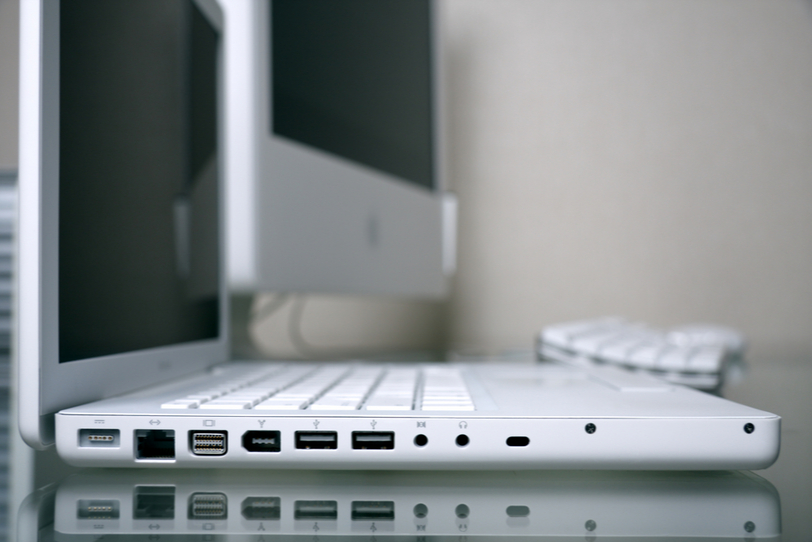
Introduction:
The hardware devices of the computer are connected to the ports. Ports are present on the motherboard of the CPU into which the cables of the hardware devices are plugged in. They play a very important role in computer networking. They act as an interface between the input devices and output devices for effective data communications and processing. Computer Port is also known as Communication Port. Some examples of devices connected to the ports are a keyboard, mouse, monitor, speakers, etc. There are different kinds of ports available.
Types of Computer Ports and their Purpose:
Computer ports are classified into two types based on the protocols used. A protocol is a set of rules and standards to be followed during data transfer and communication. Usually, data is transmitted in a particular pattern.
- Serial Port
- Parallel Port
Serial Port is a port to which the hardware devices are connected in a serial pattern. The data travels in one single direction for communication and processing. The data travels over one single communication line only. D – subminiature is an example
Parallel Port is a port to which the hardware devices are connected in a parallel pattern. The data travels more than one direction for communication and processing. The data travels over more than one communication lines in a parallel direction. Printer Port is an example.
There are a number of ports available that are either serial or parallel in nature.
Different Computer Ports Available:
-
PS/2 Port:
Hardware Devices like mouse and keyboard are connected to this port. It was developed by IBM. This is a serial type port. It is also called a mouse port. There are two PS/2 ports on desktop computers. The color code for a keyboard is purple and a mouse is green.
-
Audio Ports:
Hardware Devices like speakers are connected to this port. The data may be analog or digital signals.
Types of audio Ports are given below:
- TRS Connector:
This port is used to connect stereo headphones. This is also used for a microphone connection. There are six connectors that are color-coded. The colors are Blue, Yellow, Orange, Black, and Grey.
- Sony/Philips Digital Interface (PDI)/ Toslink:
These ports are used to connect home media.
- Video Ports:
These ports are found in many computers and are used to connect projectors, video cards, and High definition TVs.
Types of Video Ports are given below:
- VGA Port: It is a 15 pin port found on many video cards, high definition TV sets, projectors, etc. It helps to transmit analog signals.
- Digital Video Interface (DVI) port: This port was developed by the Digital Display Working Group. It is used to connect a video device controller to the monitor.
- Mini DVI and Micro DVI: These ports are the smaller versions of DVI. They were developed to reduce space. They transmit signals through adapters.
- Display Ports:
This port is a digital display connector. It was developed to replace the VGA ports and the DVI ports.
- High Definition Media Interface (HDMI):
HDMI port is used to connect high definition devices to the computer like HD cameras, HD TVs, monitors, etc.
- Universal Serial Bus (USB) Ports:
These ports were developed to replace the serial ports and parallel ports. They are used as power supplies for the connected devices. There are three types of USB Ports namely Type A, Type B, and Micro USB.
- Registered Jack (RJ)-45:
These ports are used for computer networking. It helps to connect to the Internet. RJ 11 is another kind of port for connections like Telephone and Modem.
- E-Sata:
The Serial AT Attachment Port is used to connect external storage devices.
In addition to the above ports, there are many other different types of ports available. Without computer ports, data transfer and communication is not possible. They are the interface through which data can transfer serially or parallelly between the connected devices. Their major function is to perform data transfer and communication effectively.
Issues with Computer Ports
There are several issues associated with computer ports. Issues should not be neglected. Even a small issue can cause a big problem. If any computer port is not functioning well, there may be a halt in services rendered by these ports.
Some of the common issues with computer ports are listed below:
- Wrong Settings – The devices to be connected should have similar parameters.
- Wrong Serial Cables
- Faulty Serial Cables
- Incorrect-Wiring
- Incompatible Software.
- Power Supplies
- Water Damage.
Dangers associated with computer ports:
The open ports of the computer are risky as they can be attacked by hackers to exploit the data. Most of the open ports help to connect with the Internet. Data may be leaked and misused through the open ports. Performing a security check is important.
The hackers have access to the FTP and UDP ports. They may install malicious files and programs into the computer which may lead to virus development. The data gets corrupted and misused; therefore, it is important to install an antivirus software program on your computer.
Some of the popular and effective antivirus software programs are Avast Antivirus, Norton Antivirus Plus, G data antivirus, Kaspersky antivirus, and many more. The ports which are no longer in use, use firewalls to protect it.
In order to avoid such issues, it is important to update the Internet services used. Your PC should always have the latest version of all the services in use. You should set up strong passwords so that hackers have no access to the data.
Having weak passwords could be dangerous as there is a chance of data leakage. HTTP and HTTPS ports are often prone to such issues, and therefore the above measures need to be undertaken.
Contact us today to learn about Bleuwire™ services and solutions in how we can help your business.





